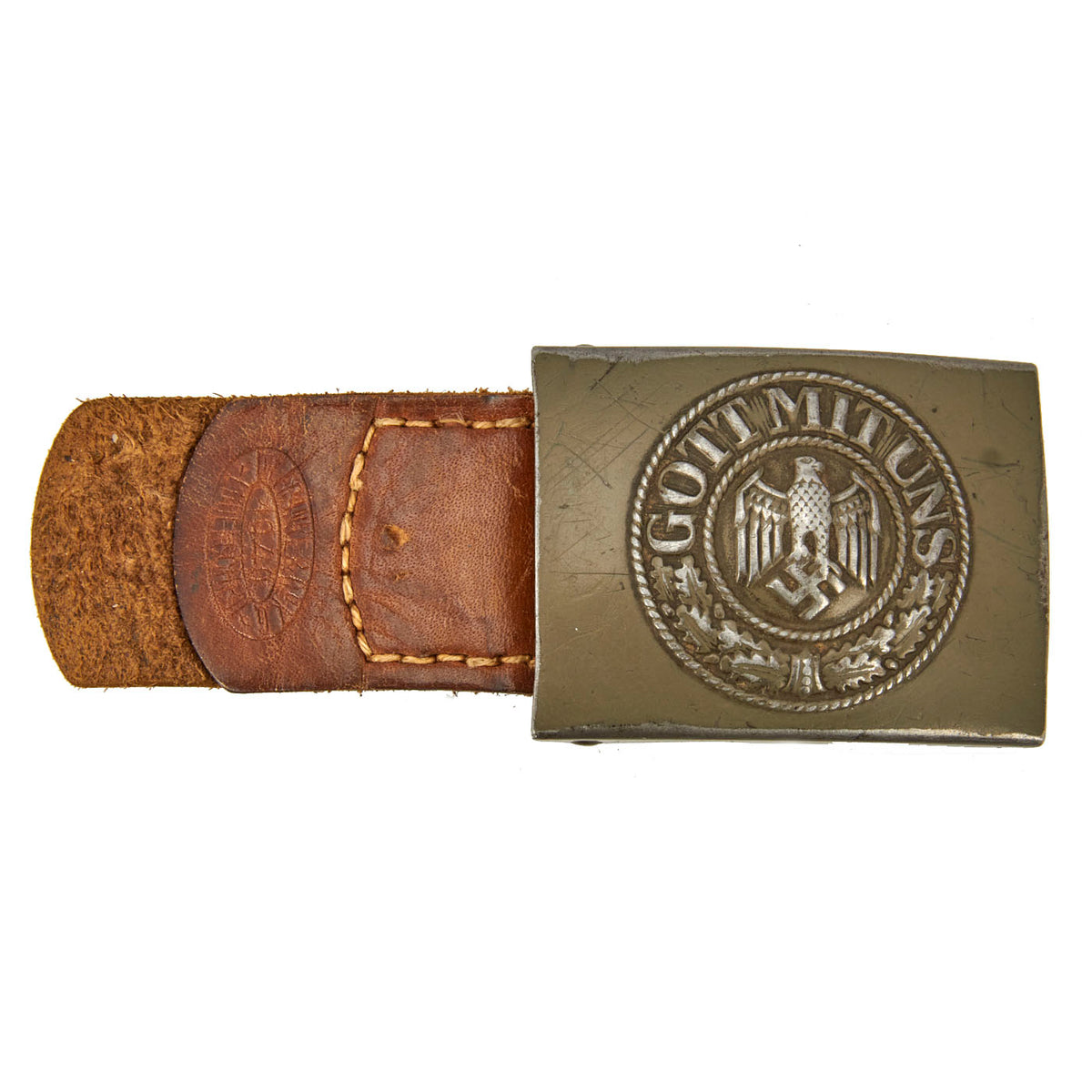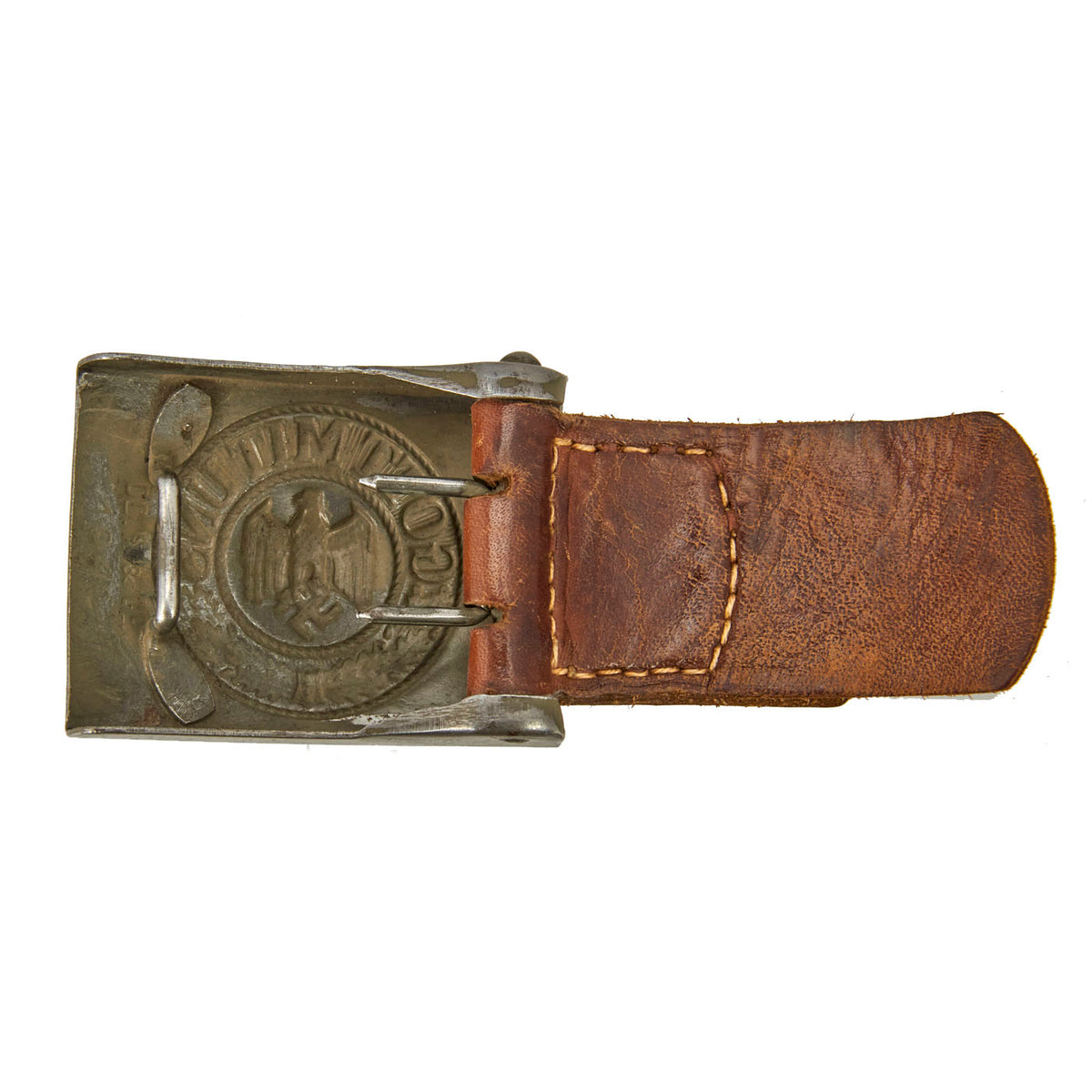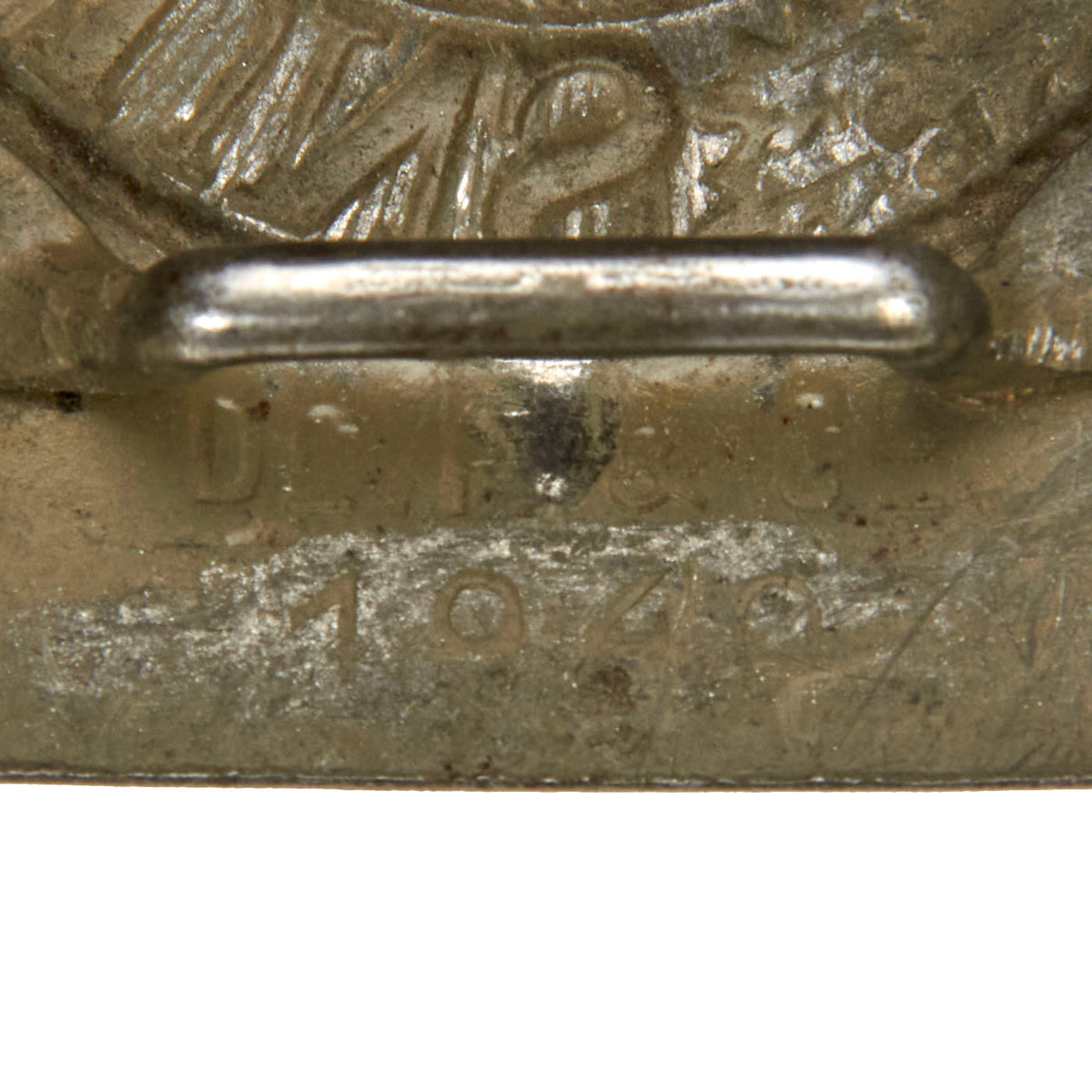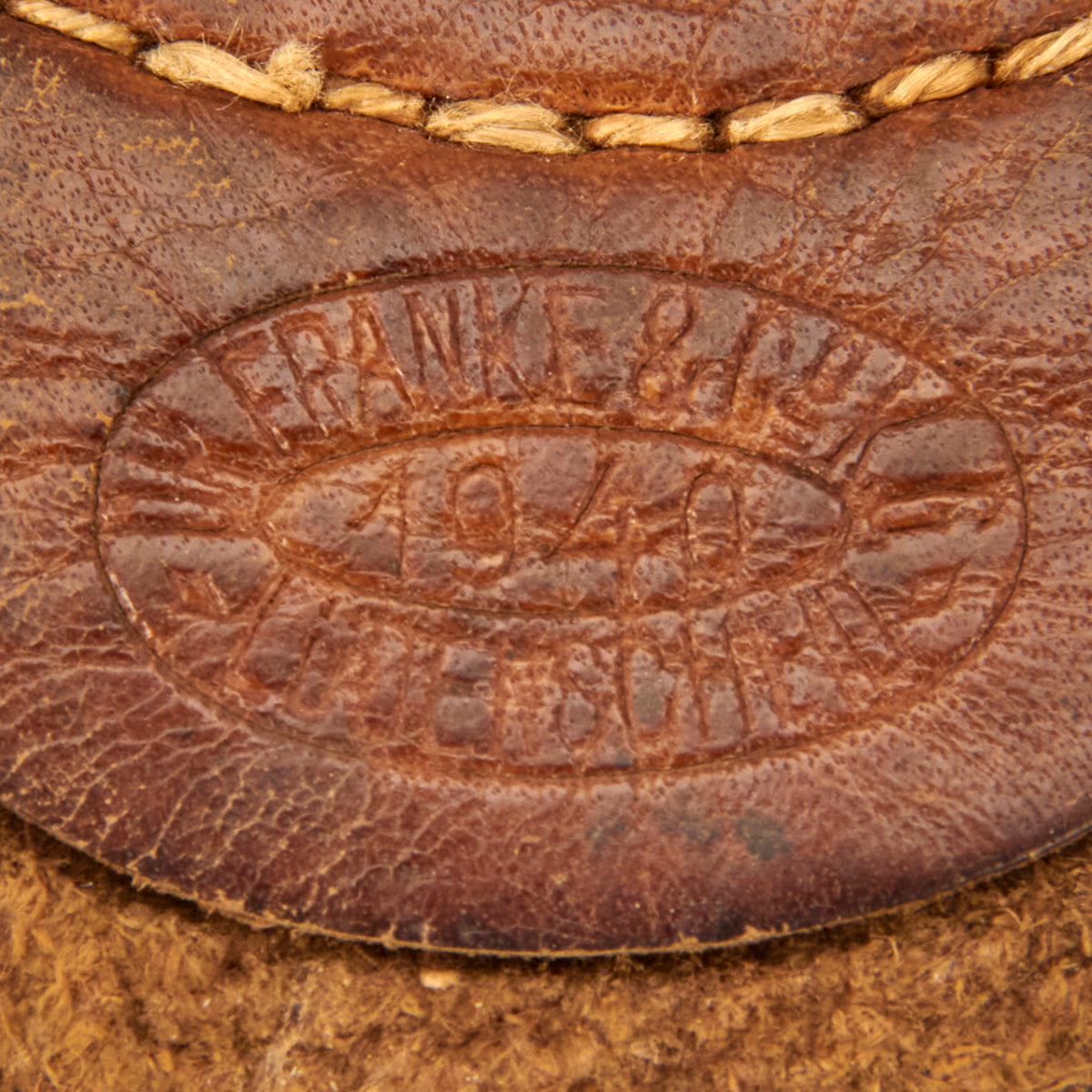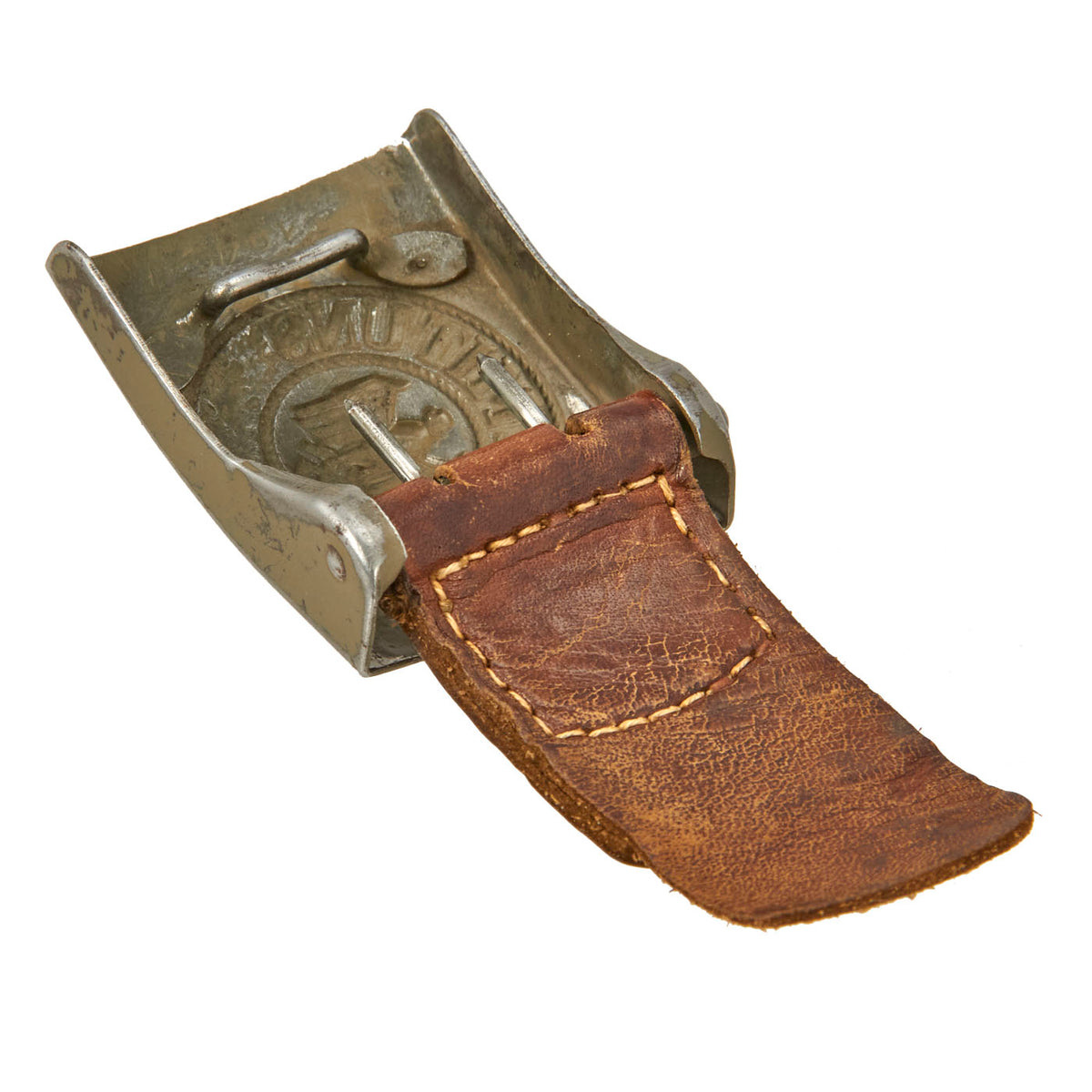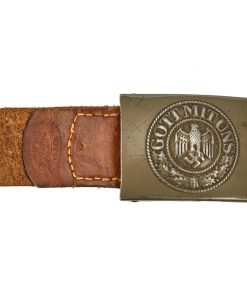Original German WWII Heer Army Painted Steel Belt Buckle With Tab by Dr. Franke & Co – Dated 1940 Original Items
$ 250,00 $ 100,00
Original Item: Only One Available. This is an excellent worn condition WWII German Wehrmacht Heer (Army) EM/NCO’s Steel Buckle (Koppelschloß). The buckle is embossed with the Heer motto GOTT MIT UNS (“God with us”) surrounding a NSDAP Party Eagle. The buckle is a nice 1940 pattern fieldgrey painted steel construction box buckle with a smooth background. The paint is present on over 85% of the buckle exterior, with just a bit of storage wear. Truly an excellent example.
The inside of the buckle is also marked Dr. F. & Co. / 1940 for Dr. Franke & Co., located in the city of Lüdenscheid, a city with a large garment accessories industry.
The buckle still still retains the leather tab, which is is very nicely marked it reads:
DR. FRANKE & CO. K
1940
LÜDENSCHEID
The leather tab is in excellent condition, still supple with a great color, and fully intact stitching.
This piece has great eye appeal, and is perfect for anyone looking to start a German belt buckle collection.
HEER / ARMY Enlisted Man, Non-Commissioned Officer Belt Buckle – (Koppelschloß mit Lederwiderhalt)
The German Army, one of the components of the Wehrmacht (Defense Force), was composed of divisional ground troops, including infantry and artillery.
Up until 1936 a standard belt buckle was used from 1919 – 1936, considered as the Weimar era. This belt buckle was replaced in early 1936 keeping the basic design of the Reichswehr buckle but adding the Wehrmacht’s stylized national eagle.
This buckle was worn during the whole Third Reich period with only small manufacturing variations. Different colors were used for the painted finish of the buckles and were determined by what uniform was to be worn with the belt and buckle.
Normally these buckles came with a leather tab that helped support the ammunition pouches, however in 1942 due to the shortages of leather this tab was discontinued, though not all manufacturers followed this trend.
Normally made of aluminum which is injected molded, the center of the buckle features the Wehrmacht Eagle with down swept wings clutching a swas. The eagle is encircled with an inner and outer simulated twisted rope border between which is an embossed oak leaf cluster on the bottom. On the top is the script “Gott Mit Uns”, (God With Us).
GOTT MIT UNS
Gott mit uns (‘God with us’) is a phrase commonly used in heraldry in Prussia (from 1701) and later by the German military during the periods spanning the German Empire (1871 to 1918), the Third Reich of NSDAP Germany (1933 to 1945), and the early years of West Germany (1949 to 1962). It was also commonly used by Sweden in most of its wars and especially as a war cry during the Thirty Years’ War. It was used for the first time in Germany by the Teutonic Order.
In the 17th century, the phrase Gott mit uns was used as a ‘field word’, a means of recognition akin to a password, by the army of Gustavus Adolphus at the battles of Breitenfeld (1631), Lützen (1632) and Wittstock (1636) in the Thirty Years’ War.
In 1701, Frederick I of Prussia changed his coat of arms as Prince-Elector of Brandenburg. The electoral scepter had its own shield under the electoral cap. Below, the motto Gott mit uns appeared on the pedestal. The Prussian Order of the Crown was Prussia’s lowest ranking order of chivalry, and was instituted in 1861. The obverse gilt central disc bore the crown of Prussia, surrounded by a blue enamel ring bearing the motto of the German Empire Gott Mit Uns.
At the time of the completion of German unification in 1871, the imperial standard bore the motto Gott mit uns on the arms of an Iron Cross. Imperial German 3 and 5 mark silver and 20 mark gold coins had Gott mit uns inscribed on their edge.
German soldiers had Gott mit uns inscribed on their belt buckles in the First World War. The slogan entered the mindset on both sides; in 1916 a cartoon was printed in the New York Tribune captioned “Gott Mit Uns!”, showing “a German officer in spiked helmet holding a smoking revolver as he stood over the bleeding form of a nurse. It symbolized the rising popular demand that the United States shed its neutrality”.
In June 1920 George Grosz produced a lithographic collection in three editions entitled Gott mit uns. A satire on German society and the counterrevolution, the collection was swifty banned. Grosz was charged with insulting the army, which resulted in a 300 German Mark fine and the destruction of the collection.
During the Second World War, Wehrmacht soldiers once again wore this slogan on their belt buckles, as opposed to members of the Waffen SS, who wore the motto Meine Ehre heißt Treue (‘My honour is loyalty’). After the war the motto was also used by the Bundeswehr and German police. It was replaced with “Einigkeit und Recht und Freiheit” (‘Unity and Justice and Freedom’) in 1962 (police within the 1970s), the first line of the third stanza of the German national anthem.
Fast Shipping with Professional Packaging
Thanks to our longstanding association with UPS FedEx DHL, and other major international carriers, we are able to provide a range of shipping options. Our warehouse staff is expertly trained and will wrap your products according to our exact and precise specifications. Prior to shipping, your goods will be thoroughly examined and securely secured. We ship to thousands clients each day across multiple countries. This shows how we're dedicated to be the largest retailer on the internet. Warehouses and distribution centres can be located throughout Europe as well as the USA.
Note: Orders with more than one item will be assigned a processing date depending on the item.
Before shipping before shipping, we'll conduct a thorough inspection of the items you have ordered. Today, the majority of orders will be delivered within 48 hours. The delivery time will be between 3-7 days.
Returns
The stock is dynamic and we cannot completely manage it because multiple stakeholders are involved, including our factory and warehouse. So the actual stock may alter at any time. It's possible that you may not receive your order once the order has been made.
Our policy is valid for a period of 30 days. If you don't receive the product within 30 days, we are not able to issue a refund or an exchange.
You can only return an item if it is unused and in the same state as the day you received it. You must have the item in its original packaging.
Related products
Uncategorized
Uncategorized
Uncategorized
Uncategorized
Australian WWII Owen MK1 Machine Carbine SMG Custom Fabricated Replica with Sling Original Items
Uncategorized
Angolan Rebel 1970s era 60mm Inert Display Mortar from Angolan Civil War Original Items
Uncategorized
Uncategorized
Uncategorized
Uncategorized
Uncategorized
Uncategorized
Uncategorized
Uncategorized
Armoured Fighting Vehicles of the World: AFVs of World War One (Hardcover Book) New Made Items
Uncategorized
Armored Burgonet Helmet & Polearm from Scottish Castle Leith Hall Circa 1700 Original Items
Uncategorized
Band of Brothers ORIGINAL GERMAN WWII Le. F.H. 18 10.5cm ARTILLERY PIECE Original Items
Uncategorized
Uncategorized
Uncategorized
